By Ann Thompson
Consulting Analyst
Sustainable Investment Group (SIG)
What does human/nature interaction look like in 2019?
 Before discussing the benefits of the natural world being visible in the office, it is essential to understand how humans are interacting with nature in the twenty-first century. According to a report released by the Environmental Protection Agency in 2018, people are spending approximately 90% of their time inside (1). Most people find a large portion of that time in their place of work, creating a need for the incorporation of nature into the work environment.
Before discussing the benefits of the natural world being visible in the office, it is essential to understand how humans are interacting with nature in the twenty-first century. According to a report released by the Environmental Protection Agency in 2018, people are spending approximately 90% of their time inside (1). Most people find a large portion of that time in their place of work, creating a need for the incorporation of nature into the work environment.
Why do humans need nature?
Research around the concept of biophilia, the idea that humans need to interact with other living organisms in nature, suggests that the benefit we get from spending time outside is unique and irreplaceable. Terrapin Bright Green, a firm specializing in biophilic design, has conducted such research and found that “the concept of biophilia implies that humans hold a biological need for connection with nature on physical, mental, and social levels and that this connection affects our personal well-being, productivity, and societal relationships” (2). This stems from the idea that homeostasis in the human body means a balanced nervous system. For anyone having trouble focusing or suffering from anxiety, the parasympathetic half of the nervous system, the rest and digest function, is what is lacking (2). Human interaction with nature jumps the parasympathetic nervous system, resulting in increased clarity of the mind, natural stress reduction, circulation, and other health benefits (3).
What does this interaction look like in the workplace?
 The simplest answer, and the solution built into the LEED Building Certification, is designing a space that allows workers to see outside through windows. Having visual access to nature during the work day means being exposed to daylight and outdoor activity. This is documented by walking through a space and noting how many workstations have access to these beneficial views. Having a high enough percentage of workspaces with windows earns credit on the LEED certification! Buildings with shallow floor plates and regularly occupied spaces on the perimeter of the building have an easier time earning this credit. It is also helpful when during the construction phase workstations are designed to enjoy natural views from a seated position.
The simplest answer, and the solution built into the LEED Building Certification, is designing a space that allows workers to see outside through windows. Having visual access to nature during the work day means being exposed to daylight and outdoor activity. This is documented by walking through a space and noting how many workstations have access to these beneficial views. Having a high enough percentage of workspaces with windows earns credit on the LEED certification! Buildings with shallow floor plates and regularly occupied spaces on the perimeter of the building have an easier time earning this credit. It is also helpful when during the construction phase workstations are designed to enjoy natural views from a seated position.
Who benefits from this design?
Designing a building in a way that is mindful of tenant exposure to daylight benefits not only the building occupants, as previously noted, but also employers. The Journal of Clinical Sleep Medicine conducted a study in 2014 to examine the impact of daylight exposure on office workers. The study concluded that workers with views of the outdoors reported higher levels of vitality and better-quality sleep. (4) These positive benefits undoubtedly translate to higher productivity at work and fewer days needed due to illness, affirming the assumption that design with natural views benefits everyone in the workplace!
Sources:
https://www.epa.gov/report-environment/indoor-air-quality (1)
https://www.terrapinbrightgreen.com/about/ (2)
https://www.wisebrain.org/ParasympatheticNS.pdf (3)
https://www.ncbi.nlm.nih.gov/pmc/articles/PMC4031400/ (4)
© 2019 Sustainable Investment Group (SIG). All rights reserved.



